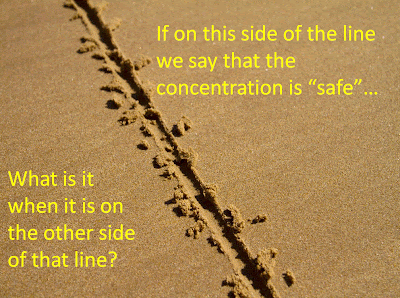My presentation was not directed at the EPA, although the EPA played a big part in it. It was geared toward the concept of how we look at risk from exposure to a chemical. Basically, I have come to accept a few tenants with regard to toxicity. The first being that there is a dose-response which brings about an acceptance that there is, therefore, a level that is safe.
If that is true, and it must be if we are to come up with a safe level, for example, the "safe" level of arsenic in apple juice or rice, we must accept this philosophy as truth. I do, and I was trying to get my audience to accept it as well. With that in mind, I put up this slide:
I thought the "line in the sand" was a good way to illustrate this concept. With that line, I could visually show what was meant by a threshold and how that threshold signifies the idea of "safe."
The problem is, once we establish a threshold, what does it mean when we fall on the other side of the "safe" line? What does being on that side mean?
This, in my opinion, is the $64,000.00 question. We have painted ourselves in a corner that is becoming increasingly difficult to get out of. Simply put, if it is "safe" over here, what is it over there? C'mon...you know what it is, and so does the general public. If it is "safe" over here it is "unsafe" over there. And unsafe requires actions to get us to the safe area.
But that's not risk of chemical exposure works. The "safe" area - the threshold - means:
"daily exposure to the human population (including sensitive subgroups) [to that dose is] likely to be without an appreciable risk of deleterious effects during a lifetime [70 years]. (EPA)
If the cornerstone of the science of toxicology is based on the individual threshold hypothesis that:
"a range of exposures from zero to some finite value can be tolerated by the organism with essentially no chance of expression of the toxic effect.” (EPA)
Then we must agree that there is an amount of arsenic in apple juice and rice that is "likely to be without an appreciable risk of deleterious effects during a [70 year] lifetime. Most importantly, we must move away from the philosophy that there is no safe level of exposure, as Dr. Honeycutt with the Texas Commission on Environmental Quality (TCEQ) is accusing the EPA of adapting
If we cannot agree that there is a "safe" level, then you might as well stop reading at this second post. If you can accept that, then we can move on.
So what is the "safe" amount of arsenic that can be in rice so that it is likely to be without an appreciable risk of deleterious effects during a [70 year] lifetime?
Consumer Reports indicates that the "safe" level is less than 5 µg/L or 5 ppb:
No federal limit exists for arsenic in most foods, but the standard for drinking water is 10 parts per billion (ppb). Keep in mind: That level is twice the 5 ppb that the EPA originally proposed and that New Jersey actually established. Using the 5-ppb standard in our study, we found that a single serving of some rices could give an average adult almost one and a half times the inorganic arsenic he or she would get from a whole day’s consumption of water, about 1 liter. (CR)
The EPA established a threshold of 10 ppb as "safe", New Jersy established a threshold of 5 ppb as "safe."
Does this mean that 5 ppb is "safe" and 6 ppb is "unsafe"? How can it be "unsafe" if the EPA says 10 ppb is "safe." And why did Consumer Reports choose the New Jersey threshold to compare the concentration of arsenic found in a serving of rice? Why 5 ppb? Is 5 ppb "safe" because it is lower than 10 ppb or is it actually - really - safe?
This is what Consumer Reports is telling their readers:
The question I'm asking - and as I write this, I don't know the answer - is 5 ppb safe making anything above that concentration "troubling", "worrisome", or "potentially harmful?"
Why 5 ppb? Why not zero?
For known human carcinogens such as inorganic arsenic, the EPA assumes there's actually no "safe" level of exposure. (CR)
If there is "no safe level" why is 5 ppb the threshold that indicates "safe." Why 5 ppb, and, if that number is acceptable, why not 10 ppb? If zero is the actual safe threshold, then 5 must pose some risk, correct? Why is that risk okay, but the risk above 5 ppb "troubling", worrisome, or potentially harmful?
Next post: Arsenic in Rice: Part 3 - Why is 5 ppb the "safe" threshold for arsenic?
.





No comments:
Post a Comment